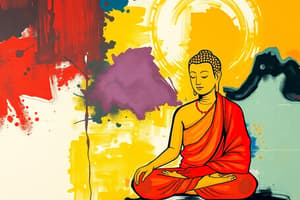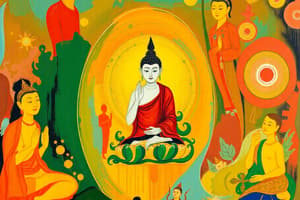Podcast
Questions and Answers
Which of the following is a central tenet shared by both Theravada and Mahayana Buddhism?
Which of the following is a central tenet shared by both Theravada and Mahayana Buddhism?
- The acceptance of the Four Noble Truths and the Eightfold Path. (correct)
- The belief in the Three Bodies Doctrine, which expands Buddha's presence.
- Emphasis on individual enlightenment through achieving Arhatship.
- The concept of the Bodhisattva Path for universal salvation.
In Early Buddhism, what role does 'intention' play within the concept of Karma?
In Early Buddhism, what role does 'intention' play within the concept of Karma?
- Intention determines the ethical quality of an action, influencing its karmic consequence. (correct)
- Only actions with good intentions lead to favorable rebirths, regardless of their consequences.
- Intention is irrelevant as the outcome of an action solely determines its karmic effect.
- Actions performed without clear intention lead to neutral karmic results.
How does Mahayana Buddhism broaden the accessibility of Buddhism compared to Early Buddhism?
How does Mahayana Buddhism broaden the accessibility of Buddhism compared to Early Buddhism?
- By restricting monastic practices to a select group of monks.
- By emphasizing individual liberation as the primary goal.
- By adhering strictly to the Pali Canon and historical Buddha's words.
- By promoting the Bodhisattva Path, which focuses on universal salvation and compassion. (correct)
What do the Jataka Tales primarily illustrate in the context of Early Buddhism?
What do the Jataka Tales primarily illustrate in the context of Early Buddhism?
What is the ultimate goal in Early Buddhism regarding Samsara?
What is the ultimate goal in Early Buddhism regarding Samsara?
Which of the following best describes the concept of 'karma' in Early Buddhist teachings?
Which of the following best describes the concept of 'karma' in Early Buddhist teachings?
How does the view on Nirvana differ between Early Buddhism and Mahayana Buddhism?
How does the view on Nirvana differ between Early Buddhism and Mahayana Buddhism?
What is the primary significance of the Three Jewels (Triratna) in Early Buddhist practice?
What is the primary significance of the Three Jewels (Triratna) in Early Buddhist practice?
Which concept is uniquely introduced and emphasized in Mahayana Buddhism, setting it apart from Early Buddhism?
Which concept is uniquely introduced and emphasized in Mahayana Buddhism, setting it apart from Early Buddhism?
What motivates practitioners to cultivate wisdom according to the concept of Samsara?
What motivates practitioners to cultivate wisdom according to the concept of Samsara?
Flashcards
Buddha
Buddha
Enlightened teacher who discovered path to liberation.
Dharma
Dharma
Teachings, including the Four Noble Truths and Eightfold Path.
Sangha
Sangha
Monastic and lay community preserving and spreading teachings.
Samsāra
Samsāra
Signup and view all the flashcards
Karma
Karma
Signup and view all the flashcards
Jātaka Tales
Jātaka Tales
Signup and view all the flashcards
Arhatship
Arhatship
Signup and view all the flashcards
Bodhisattva Path
Bodhisattva Path
Signup and view all the flashcards
Early Buddhism focus
Early Buddhism focus
Signup and view all the flashcards
Mahāyāna Buddhism
Mahāyāna Buddhism
Signup and view all the flashcards
Study Notes
- Early Buddhism prioritizes self-liberation, ethical behavior, and wisdom
- Key concepts in Early Buddhism include the Three Jewels, Samsara, Karma, and Jataka Tales
Three Jewels (Triratna)
- The Buddha represents the enlightened teacher
- Dharma constitutes the teachings, including the Four Noble Truths and the Eightfold Path
- Sangha is the monastic and lay community
Samsara (Cycle of Rebirth)
- Samsara involves the continuous cycle of birth, death, and rebirth
- Karma and ignorance fuel this cycle
- Liberation (Nirvana) ends the cycle
Karma (Cause & Effect Law)
- Actions result in consequences in this life or future rebirths
- Favorable rebirth is a consequence of good actions and unfavorable rebirth comes from bad actions
- Intention is important and influences karma
Jataka Tales (Buddha's Past Lives)
- Jataka Tales consist of moral stories from Buddha's previous incarnations
- Compassion, wisdom, and patience is taught
- Examples include The Monkey King and The Deer King
Early Buddhism vs. Mahayana Buddhism
- Both Early Buddhism (Theravada) and Mahayana Buddhism share fundamental ideas but have different goals, teachings, and practices
- Arhat versus Bodhisattva, perspectives on Nirvana, Sutras, and metaphysics are key differences
Similarities
- Both have the Four Noble Truths and the Eightfold Path
- Samsara, Karma, and Nirvana are central to both
- Both include the Sangha, with Mahayana having more laypeople
Key Differences
| Feature | Early Buddhism (Theravada) | Mahayana Buddhism |
|---|---|---|
| Goal | Become an Arhat (self-liberation) | Become a Bodhisattva (saving all beings) |
| Ideal Figure | Arhat - Enlightened individual | Bodhisattva - Delays Nirvana to help others |
| Sutras (Teachings) | Pali Canon - Focus on historical Buddha | Mahayana Sutras - Expands teachings |
| View on Nirvana | Nirvana = Final escape from samsara | Nirvana=Not separate from the world |
| Metaphysics | Focus on impermanence, no-self | Introduces Emptiness, Buddha-nature |
Mahayana Innovations
-
Bodhisattva Path means focusing on compassion over individual enlightenment
-
Emptiness (Sunyata) is Nagarjuna's Madhyamaka philosophy
-
Three Bodies Doctrine means Buddha's presence goes beyond the historical form
-
Both traditions share common roots but differ in their approach to enlightenment
-
Theravada Buddhism is focused on individual liberation, while Mahayana Buddhism seeks universal salvation through compassion and wisdom
Studying That Suits You
Use AI to generate personalized quizzes and flashcards to suit your learning preferences.




